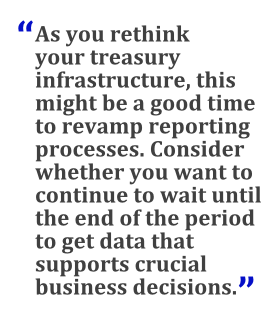 CFOs, treasurers, and otherfinance professionals are under constant pressure to make the bestpossible decisions with their company's working capital “in themoment.” This pressure can be especially intense within a globalcompany that has liquid assets residing around the world.
CFOs, treasurers, and otherfinance professionals are under constant pressure to make the bestpossible decisions with their company's working capital “in themoment.” This pressure can be especially intense within a globalcompany that has liquid assets residing around the world.
For example, an organization may have several foreign accountsin which it holds a significant portion of its assets, liabilitiesdue (which may or may not include incentives to pay early), and stocks in foreign corporations.The company must optimize performance of all of these accounts,keeping in mind exchange rates, taxes (factoring in transfer pricing and related issues), and a number of othervariables.
|The more complicated a company's financial picture, the moredifficult it is for finance managers to know when they should moveliquid assets between countries, when to reinvest or sell stocks,and whether the organization should pay off liabilities or take ondebt. That's why, for many complex global organizations, usingtechnology to gain a consolidated, real-time view into the company's cash positionis not the next “best practice,” it's just the nextpractice.
|But picking the right system is crucial. Here are some keyquestions that companies need to answer as part of the cashmanagement software selection process.
||

Does your company have global accounts, or onlydomestic accounts? Every company shopping forcash management software needs to make sure the packages on itsshortlist are built to support the markets in which the companyoperates. Each country, state, and region has unique laws andregulations pertaining to taxation and employment. Financialsoftware can be a huge asset in ensuring that purchases,investments, and hiring practices meet all relevant rules, withouttying up the legal team's time unnecessarily.
|This is especially relevant when it comes to doing business witha new bank. If a bank has a negative rating, and the cashmanagement system can provide reports on the assets and cash withinthat bank, this may impact corporate treasury guidance. Ideally,the system would allow treasury to set policies to protect cashflows and investments, and would generate robust reports to helpcash managers initiate preventative actions.
||

Does local bank information flow into your globalsystems? When your company is making majorbusiness decisions—for example, determining the financial benefitsand constraints of new products or services—decision-makers need aclear picture of all relevant business data. By tying together alldata from treasury and then integrating it into the enterpriseresource planning (ERP) system, a company makes all necessaryinformation available in one place.
| However,most governments have laws about the flow of assets from entitiesbased within their borders to those based outside of them,including between banks. Bank communication capabilities aretypically bound to the specifics of the underlying ERP; this meansthat with the right solution, diverse communication channels can beautomated and managed with minimal manual effort. An effectivesolution allows a company to link from its ERP either directly tothe bank or, alternatively, to SWIFT or other networkproviders.
However,most governments have laws about the flow of assets from entitiesbased within their borders to those based outside of them,including between banks. Bank communication capabilities aretypically bound to the specifics of the underlying ERP; this meansthat with the right solution, diverse communication channels can beautomated and managed with minimal manual effort. An effectivesolution allows a company to link from its ERP either directly tothe bank or, alternatively, to SWIFT or other networkproviders.
Additionally, if banking information is integrated into yourglobal business, you'll have very real security concerns aboutkeeping your clients' and investors' information safe. If we talkabout underlying ERP systems, the security improvements areinherited through the elimination of manual data entry steps, alongwith the obvious advantages of time and cost savings.
|A close connection between treasury and ERP allows users to gobeyond just analyzing the data: Teams are able to drive immediateinsight to action, with all changes reflected in the generalledger.
|
Do you require multilingual software for sharingtreasury data between business units? If your company has offices in many different countries, it'sunlikely that all of your employees will speak the same language.As you decide on a financial system, think about systems that canproduce forms, databases, and dashboards you'll need available inthe different languages your employees speak. This may also be arelevant consideration for companies that operate onlydomestically, but do so in a large country such as the UnitedStates, Canada, China, Russia, or Spain, as local employees inthese nations may speak a variety of native languages.
| Alongthe same lines, consider whether the financial systems on yourshortlist are localized in ways that go beyond language. Considerwhether each software package includes forms, definitions, etc.,that would streamline your foreign operations' ability to meetcountry-specific regulations and to abide by local customs, asappropriate.
Alongthe same lines, consider whether the financial systems on yourshortlist are localized in ways that go beyond language. Considerwhether each software package includes forms, definitions, etc.,that would streamline your foreign operations' ability to meetcountry-specific regulations and to abide by local customs, asappropriate.
|

Are all staff members employees, or is there a mixof employees and contractors? Witheach new hire come more regulations. From tax paperwork to benefitsfilings, each head under your company's roof must be accounted for,reported on, paid, and served in often highly individualized ways.With many companies turning to contingent labor to fill theirtalent gaps, accounting for dispersed payroll information after thefact can be a challenging process.
|While it may seem that payroll and treasury are separate, anefficient and accurate payroll system will allow for faster andmore impactful cash forecasting, which will mean less guessing whenit comes to future investment opportunities. The right platform canalso provide an intuitive system that keeps straight the needs ofeach employee and contractor. As a global business hires workersoverseas, corporate finance needs to make sure that the company iscomplying fully with local laws and regulations, and needs to havelegal and tax information available to accommodate needs of theforeign government.
|
How complicated is your company's inventoryprocess? This is especially applicableto e-commerce brands, but it can apply to all industries. Whenselecting software for treasury and cash management, make sure tokeep in mind how complicated your organization's inventory processis, and what numbers must be recorded and tracked. For example, apaper manufacturer may need to track the cost, weight, and sourceof its pulp and resulting products, but may not need to havepackaging data readily available for its inventory. However, afromager most certainly will—for both supplies and products.
|Like payroll, inventory has historically seemed worlds away fromtreasury, though the two interact heavily. However, with the rightsolution, all data can be pulled into one central platform thatallows for more accurate forecasting by factoring in all expensesthe company can expect to incur.
|
How does your supply chain work? Does your company generally deal with vendorsthrough simple, one-off transactions? Or does it tend to haveongoing relationships that entail automatic purchase orders andregularly scheduled deliveries of new material? Are there globalmaster contracts in place? Do the contracts include a dynamicdiscounting function? Do some of your vendors exchange theirproducts and services for your own, instead of currency-basedtransactions? These are all incredibly important questions toconsider when deciding which treasury management software solutionwill work for your organization, and how it should interact andintegrate with your supply management system.
|For example, in the case of a complicated, global supply chain,you'll want to look for a cash management solution that factors inbanks and SWIFT, marketplaces and dealing platforms such as FX Alland 360T, and market-data providers such as Bloomberg and Reuters.It is also important for a system to factor in legal compliancestandards, such as EMIR in Europe.
|
How does your company use financial forecasting? Companies that have only regional or localbrands, work with local vendors, and are privately owned may notprioritize having up-to-the-minute financial reporting. However,every public company—as well as every private company that isthinking of going public, that has investors to report to, or thatwants peace of mind for its leadership team—needs a treasury systemthat can provide details, at a moment's notice, about exactly whereall of the organization's assets lie.
| The main forecasting-related differentiators among cashmanagement software packages revolve around the creation ofreports. How frequently do you expect to need to run financialreports? How quickly do you expect them to take to compile? And howmuch detail are you likely to be looking for?
The main forecasting-related differentiators among cashmanagement software packages revolve around the creation ofreports. How frequently do you expect to need to run financialreports? How quickly do you expect them to take to compile? And howmuch detail are you likely to be looking for?
Consider your current cash forecasting and financial reportingprocesses. If today you're generating specific reports at a regularinterval, you'll need to make sure the treasury systems you'reconsidering can support that schedule. Of course, as you rethinkyour treasury infrastructure, this might also be a good time torevamp reporting processes. If your current reporting process iscumbersome, consider whether you really want to continue to waituntil the end of the period to get data that supports crucialbusiness decisions. If you're thinking about rolling out real-timeor rolling forecasting, evaluate whether the treasury systems onyour shortlist can support these needs as well.
||

To what degree would you prefer for financialoperations to be automated? Sophisticated software systems have the potential to save financeand treasury staff from a great number of manual activities. Forexample, does your finance team currently dedicate large swaths oftime to the monthly reporting process? The right treasurymanagement system can automate the entire reporting process, sothat a large variety of data can be compiled into beautifuldocuments with a few clicks of a button.
|Ultimately, this question comes down to the investment that yourorganization is willing to make in financial software in order tofree up employee time for more analytical activities like scenarioplanning and similar simulations.
||

Will your customers have a portal through which theycan check the status of their account? If youhave an online portal that customers can log into, there's likelyat least a small component that addresses their financialinvolvement in the company—whether it's a screen that shows recentpurchases, status of open orders, or the state of the customer'spayment plan. Consider whether this is a value-add to your clientbase, and how much it improves customer experience. Would treasurysoftware that provides instant updates to such a portal be worththe investment? There are some cash management platforms thatprovide this type of functionality, and companies that use it oftenfind it a boon for customer satisfaction and experience.
||

Does your finance system connect to a businessnetwork? If you use a vendor network, or if youwork in cohort with other companies to produce a joint product,it's very important that your brand match the financial records andreporting capabilities of those companies in order for necessaryfiling to go smoothly and regulations to be met by all thoseconcerned. Having a cash management system that integrates into therest of your management software is integral to the efficiency atwhich your business operates. Instead of having to plug in numbersfrom one software into another, and figure out which is the rightnumber, the platforms should be interconnected and automated.
||

Do you have an integratedbusiness planning process that balances finance with supply anddemand? If yourorganization often makes investments in other businesses, or offersbusiness or consumer loans, your solution of choice must enable thefinance department to forecast the repercussions of decisionsaround those transactions before they're made.
|If you can manage, within your long-term forecast (e.g.,12-month time horizon), the forecasted inflows and outflows perliquidity item (purchase or investment) and currency, you canbetter define a strategy on how to hedge certain foreign exchange(FX) fluctuations. For example, if you are a USD-functionalcompany, and you expect over a six-month time frame to see a highoutflow of EUR or CHF that cannot be netted with an inflow, thenyou need to hedge your anticipated outflows against the FX risk.
|By being able to see the impact in full, and organize yourfinancial allocation, you can eliminate surprises and move assetswith total confidence.
|The pace of business is moving too fast for finance to fallbehind. If you decide to take control of your company's cash byimplementing cash and liquidity management software, answeringthese 11 questions will provide a solid foundation for the duediligence process around software selection.
|———————————————
| Henner Schliebs is vice president and head offinance audience marketing for SAP. He has over 15 years ofexperience working in the big data and finance industries, and ispart of the team spearheading SAP's Simple Financeinitiative.
Henner Schliebs is vice president and head offinance audience marketing for SAP. He has over 15 years ofexperience working in the big data and finance industries, and ispart of the team spearheading SAP's Simple Financeinitiative.
Complete your profile to continue reading and get FREE access to Treasury & Risk, part of your ALM digital membership.
Your access to unlimited Treasury & Risk content isn’t changing.
Once you are an ALM digital member, you’ll receive:
- Critical Treasury & Risk information including in-depth analysis of treasury and finance best practices, case studies with corporate innovators, informative newsletters, educational webcasts and videos, and resources from industry leaders.
- Exclusive discounts on ALM and Treasury & Risk events.
- Access to other award-winning ALM websites including PropertyCasualty360.com and Law.com.
*May exclude premium content
Already have an account? Sign In
© 2024 ALM Global, LLC, All Rights Reserved. Request academic re-use from www.copyright.com. All other uses, submit a request to [email protected]. For more information visit Asset & Logo Licensing.







